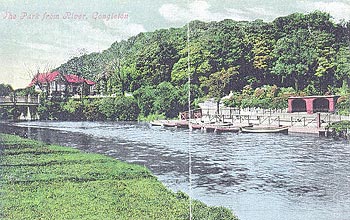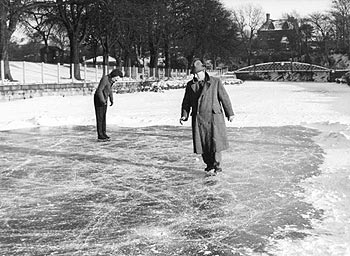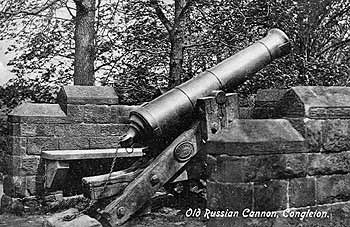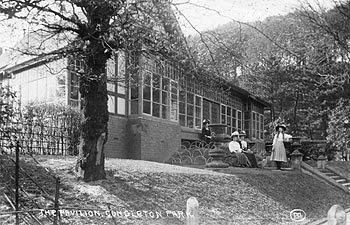The History of Congleton Park
Conception, Design and Opening of Congleton Park

Following a movement to create public parks in the nineteenth century in 1856 the Town Council bought twelve acres of land between Town Wood and the river Dane with the object of creating an open space in which to lay out a public park. A park committee was appointed but seemingly they needed reassurance about the site. One advisor to whom they applied was James Bateman who had developed a series of impressive gardens at Biddulph Grange. The Congleton and Macclesfield Mercury reported on 27 October 1860:
‘We understand that James Bateman, Esq. The Grange, has in the company with other members of the Park Committee declared the spot admirably suited to the purpose contemplated (A Public Park)’
As parks were a matter of public pride their design was as important as that of public buildings, which were built on a grand scale with meticulous attention to detail. Just as a notable architect was employed to design buildings, so equivalent landscape designers and gardeners were employed for the parks
The designer of Congleton Park was Edward Kemp who was helped by the Congleton surveyor William Blackshaw. Kemp had worked under the supervision of Joseph Paxton at Chatsworth. In September 1843 he became Head Gardener and subsequently superintendent at Birkenhead Park. Later he was consulted on the designs for Central Park in New York.
His main aims and many of his ideas were the result of having being trained by Paxton. These ideas included providing open spaces, together with formal bedding and rockeries and a mixture of evergreen trees with the border shapes of native trees. In Congleton Park Paxton’s principles are particularly noticeable in the carriageway running round the outside of the park and in its proximity to the river. Paxton always emphasised water features. He also encourages the creation of formal gardens and pathways running through them and areas ‘for the passive enjoyment of the park’s scenery’. Kemp provided these features as well as seating and viewing points in the park and in the Town Wood. Adhering to Paxton’s designs he also allowed a large amount of open space surrounded by trees.
In time other characteristics came to be added - a bowling green and a croquet lawn and provision for boating was made. In addition he created a network of winding paths through the wood, many designed to create unexpected twists and views. The paths in Town Wood culminated in a high view point, which later became the site for the Russian cannon.
Congleton Park was opened in 1871
The Bridges

Access to the park was a bridge at the end of Park Road but a second wooden bridge at the end of a path from Willow Street was provided by the end of the nineteenth century. The bridge was accompanied by a fete for its opening. 7000 people are reported to have watched the red, white and blue silk cord being removed to declare the bridge open. The games included a pillow fight on a pole laid across the river, and crossing a greasy pole across the river, pig chase in the park meant chasing a well-soaped pig. The Congleton excelsior band provided music. This bridge lasted several years before it was replaced in 1976 by the present bridge.
The Circular Fountain
Kemp’s preference for a rockery set in formal garden can be seen in the circular fountain added in 1886. This, made with a base of Biddulph Moor stone, was placed in the middle of a circular flowerbed.
The Drinking Fountain
A second fountain (now obsolete in use) and placed in the park once stood at the bottom of Swan Bank. This was a gift to the town by Mrs. Howard of Brereton Hall in 1887 to commemorate Queen Victoria’s Golden Jubilee. It remains a focus for this part of the town being both a drinking fountain for horses and a lantern. Iron cups were added to it to allow people to also have a drink.
The Russian Cannon

The Crimean war (1845-1856) fought by the French and British against the Russians resulted in a large number of cannons being captured, many being taken after the siege of Sevastopol. The war office, not willing to use these, decided to offer them to towns and cities in England as trophies. The Town Clerk seemingly applied for a cannon in January 1859 and the application was accepted. The cannon arrived at Congleton Station on 14 June 1859 and was escorted into the town in an ‘immense procession’ led by five men who had fought in the Crimea war. At first the cannon was placed on a specially built platform situated either at the bottom of Moody Street on an open space now outside the Royal bank of Scotland or on the other side of the street in front of ‘Mr Deakin’s shop’, which is where Woolworths was replaced by B&M. By 1871 it seems to have become an anachronism and the opening of the park seemed to be a suitable opportunity to move it to a mock fort emplacement at the top of the Park wood. During the Second World War the demand for metal led to a debate by the Town Council for the cannon to be donated to help the war effort.
The Pavilion
The Pavilion was built to commemorate the Golden Jubilee of Queen Victoria in 1887. At one end was placed a bell reputed to have been cast in 1720 and weighing about half a hundredweight. It originally stood near the Mill Green entrance to the park in a small cabin. The bell was sounded each evening to denote closing time in the Park.

The pavilion was in great demand for social events including wedding receptions and other functions. It survived until the 1980s when vandals attacked it and it was partly gutted by fire and was then boarded up, a sorry remnant of a once social past before it’s restoration in 2005.
The Bandstand
The bandstand was added to the park in 1914 as a result of a demand by Dr William Isaac Fern (Mayor 1911-1913) that provision should be made for public entertainment. A Carnival held in September 1913 seems to have raised enough money to cover the cost and Dr Fern opened the bandstand on 11 April 1914.
A commemorative stone is incorporated into the wall to mark the visit of King George V and Queen Mary to the town on 23 April 1913.
The Market Cross
In 1772 the market cross was declared a nuisance and pulled down. The Coronation of Edward VII in 1902 resulted in a revival of civic pride. The Congleton Chronicle appealed for anyone who knew the whereabouts of pieces to the old cross to bring them to the town hall. A number, including two stone blocks at the base of the shaft, were recovered and incorporated into a new structure. This was erected in Lawton Street Gardens on 26 of June 1902 to mark the Coronation. It was used as the first war memorial in 1919 but once a permanent memorial had been established in 1923 the cross was moved to the north entrance of the park standing at the end of the triangle of grass. In 1953 it was moved to a more central position.
Congleton Parks Today
Following a period of decline the Park and adjacent Town Wood were restored in 2005 largely with the aid of The Heritage Lottery Fund which was greatly assisted and supported by the Community. The Park was sympathetically restored to its former glory with a view to preserving Kemp’s original design, it’s historical features and the wood’s status as a Site of Biological Importance.
This Information was provided with kind permission of Margaret Williamson, MBE (deceased) who was a Friend of Congleton Park
Contact Parks and gardens
Report an issue - for example,
broken playground equipment, benches, gates, fences or other grounds maintenance issues in parks and play areas.
For all other queries, email park enquiries.
Phone: 0300 123 5011
Page last reviewed: 23 April 2025
Thank you for your feedback.